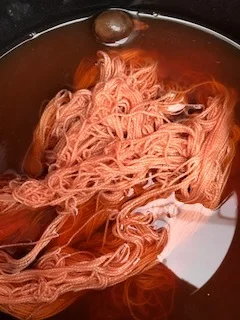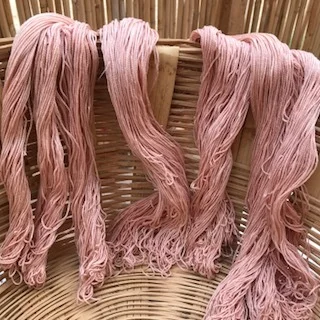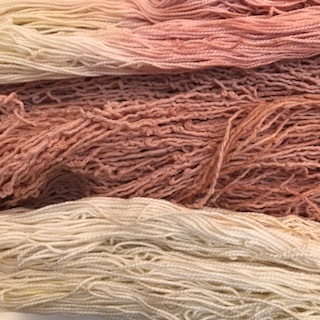Dyeing with Avocado Pits
Cotton String, Just placed in dye bath.
Cotton String, three days later. The color will fade once the string is rinsed.
I thought I would share a post about dyeing with avocado pits. It's incredibly easy and safe to do at home. Natural dyeing is a great way to give old clothes new life, and avocado pits yield a gorgeous blush pink; all of your white shirts might become pink after trying this!
What you'll need:
(This recipe is for dyeing one shirt, approximately)
Something to Dye. Natural fibers only. Silks and wools take natural dyes better, but cotton, linen and hemp work great as well. For the light pink avocado dye, the textile should be white or light in color.
A pot big enough to let your textile move freely in the pot, that is dedicated to natural dyeing. (As a rule, keep dye pots of dyeing, and pasta pots for pasta). A big stock pot from the thrift store works great.
Dedicated dye Tongs
Soy Milk
10-15 Avocado pits, washed of any flesh. More pits will yield a deeper color. Hello homemade guacamole! I rinse and store my pits in a bag in the freezer until I'm ready to use them. (more dye stuff= darker dye, as a general rule)
Here We Go!:
Preparing your fabric, or Mordanting.This is extremely important for cellulose fibers, but should be done on all fibers. It makes the fiber more receptive to dye and will keep the dye brighter longer.
Wash your fabric. Assuming you are upcycling an old shirt, this has been done many, many, times.
Fill the dye pot about 3/4 of the way full with water and mix in about a 1/2 a cup of soy milk. Soy milk has protein cells that stick to the natural fibers making it more dyeable.
Wet your fabric throughly and wring out. Submerge your fabric in the soy milk mixture over night. In the morning, wring out the fabric, but do not rinse and hang to dry. Repeat 2-3 times. The more protein fibers on the fabric the better, but two times in the soy milk works just fine. You can reuse your soy milk mixture. I put mine in the fridge while my fabric is drying to keep it from going sour.
You should now have a soy milk infused by dry textile and a clean dye pot.
Fill the dye pot 2/3- 3/4 of the way up with water. Enough water to cover your textile completely. Add the avocado pits and simmer for an hour. After an hour, turn heat off and let your avocado pit juice cool completely. You can strain your dye juice now, or leave your pits in the water. I personally think I get a darker color by leaving the pits in. But up to you. Experiment!
You can add the textile to your dye pot and bring the heat up again. Keep the pot from boiling, but hot is good. Keep the heat up for about an hour, then turn off and let cool, while leaving your fabric to soak.
The longer the fabric soaks the more intense the dye. Leave for 24-48 hours.
Remove the fabric and rinse in cold water. Hang to dry. To keep the dye from fading fast, hand wash in cold water and hang dry. Though washing in a machine on cold works too.
The avocado pits can be composted and the avocado juice saved to dye again (though it will dye a lighter shade of pink unless more pits are added).
Natural dye can be a bit unpredictable. But thats what makes it so much fun. There are so many variants with plant based dyes that no two batches are ever exactly the same. More dye stuffs will give a darker color, less water might give a darker color, fabric material will effects the dye color as well. Ive had avocado dye baths from the lightest blush pink, to orange-y pinks, to a light raspberry color.
Please share your natural dye adventures with us by tagging us in your photos @four.rabbit
The string laid out to dry after its been rinsed in cold water.
Avocado dyed string, partially dipped and fully soaked.




